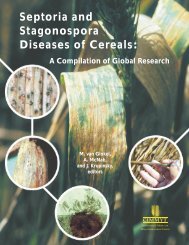Teosinte Distribution in Mexico - CIMMYT: Seeding innovation ...
Teosinte Distribution in Mexico - CIMMYT: Seeding innovation ...
Teosinte Distribution in Mexico - CIMMYT: Seeding innovation ...
You also want an ePaper? Increase the reach of your titles
YUMPU automatically turns print PDFs into web optimized ePapers that Google loves.
30 <strong>Teos<strong>in</strong>te</strong> distribution <strong>in</strong> <strong>Mexico</strong><br />
Herbarium specimens and ethnobotanical<br />
<strong>in</strong>formation<br />
Figures 1 to 13 and Table 1 list <strong>in</strong>formation on<br />
teos<strong>in</strong>te populations from botanical samples or other<br />
varied sources. Farmers and cattle ranchers are the<br />
most common sources, but <strong>in</strong>formation has also come<br />
from taxonomists and agronomists who work<br />
directly with farmers and ranchers. The <strong>in</strong>formation<br />
<strong>in</strong> the figures and table is considered reliable and of<br />
potentially great use <strong>in</strong> plann<strong>in</strong>g exploration and<br />
collection trips. Sites <strong>in</strong> the states of Chihuahua,<br />
Jalisco, Oaxaca, and Chiapas are of particular <strong>in</strong>terest;<br />
confirmation of teos<strong>in</strong>te’s existence there would<br />
permit the study of genetic diversity <strong>in</strong> a latitud<strong>in</strong>al<br />
cont<strong>in</strong>uum, cover<strong>in</strong>g a large number of ecosystems<br />
beg<strong>in</strong>n<strong>in</strong>g <strong>in</strong> Chihuahua at almost 30° N and end<strong>in</strong>g<br />
<strong>in</strong> Nicaragua close to 13° N.<br />
Potential areas of teos<strong>in</strong>te<br />
distribution<br />
The preced<strong>in</strong>g describes locations where teos<strong>in</strong>te’s<br />
presence is either reported by non-technicians or<br />
where its presence has been confirmed through direct<br />
observation by a recognized expert. It is widely<br />
believed, however, that heretofore undescribed<br />
teos<strong>in</strong>te populations exist <strong>in</strong> <strong>Mexico</strong>. One approach<br />
for encounter<strong>in</strong>g such populations would be to def<strong>in</strong>e<br />
ideal environments and then search for areas and<br />
locations that fit the parameters def<strong>in</strong>ed, us<strong>in</strong>g a<br />
geographic <strong>in</strong>formation system. The follow<strong>in</strong>g<br />
section describes an experiment which follow this<br />
approach to identify potential areas of teos<strong>in</strong>te<br />
distribution <strong>in</strong> <strong>Mexico</strong>, outl<strong>in</strong><strong>in</strong>g the methodology<br />
and prelim<strong>in</strong>ary results for the Balsas and Central<br />
Plateau races <strong>in</strong> the Central Pacific Region of <strong>Mexico</strong>.<br />
First, altitude, temperature, and precipitation<br />
parameters were def<strong>in</strong>ed for teos<strong>in</strong>te for sites where<br />
seed of the maize wild relative has been collected <strong>in</strong><br />
the states of Colima, Jalisco, Michoacán, and Nayarit<br />
(Table 2 lists requirements for Balsas and Central<br />
Plateau races — results for these two races are<br />
presented, because data are available from many<br />
sites). To search for potential areas of teos<strong>in</strong>te<br />
distribution, an INIFAP geographic <strong>in</strong>formation<br />
database for the Central Pacific region was used,<br />
work<strong>in</strong>g at resolutions of 900 x 900 m. Us<strong>in</strong>g this<br />
database and the IDRISI system, altitude, annual<br />
temperature, and annual precipitation maps were<br />
reclassified as a function of the ranges listed <strong>in</strong> Table<br />
2. The reclassified maps were then overlaid to f<strong>in</strong>d<br />
potential areas of distribution for Balsas and Central<br />
Plateau teos<strong>in</strong>te (Figs. 14, 15). For the Balsas race,<br />
21,014 km2 of possible teos<strong>in</strong>te areas, represent<strong>in</strong>g<br />
12% of the region, was found <strong>in</strong> four states (9,425 km2 <strong>in</strong> Jalisco, 7,883 km2 <strong>in</strong> Michoacán, 3107 km2 <strong>in</strong><br />
Nayarit, and 599 km2 <strong>in</strong> Colima). For the Central<br />
Plateau race, 2,151 km2 (1.2% of the region) of new<br />
areas was detected; 1,307 km2 <strong>in</strong> Jalisco and and 843<br />
km2 <strong>in</strong> Michoacán.<br />
Common names of teos<strong>in</strong>te<br />
<strong>in</strong> <strong>Mexico</strong><br />
Closely related to the issue of teos<strong>in</strong>te distribution <strong>in</strong><br />
<strong>Mexico</strong> and of considerable importance <strong>in</strong> study or<br />
collection efforts are the common names given the<br />
species (Table 3). These names are generally based on<br />
some resemblance of the plant to maize, or on the<br />
names of birds which, accord<strong>in</strong>g to the local<br />
Table 2. Altitude, temperature, and precipitation<br />
for the distribution areas of two<br />
teos<strong>in</strong>te races.<br />
Average annual Average annual<br />
Altitude temperature precipitation Slope<br />
Race (masl) (°C) (mm) (%)<br />
Balsas 620-1550 19.8-27.7 840-1265<br />
Central<br />
Plateau 1530-2000 15.9-19.6 800-916 < 4









